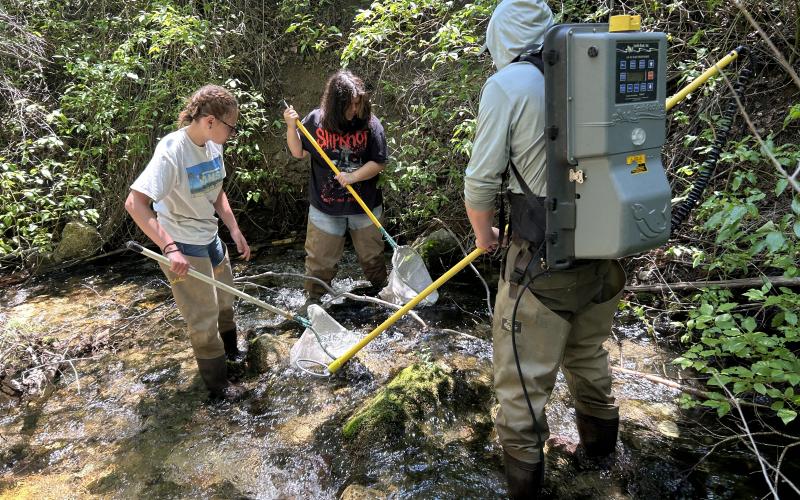Tribal Relationship Building with Great Basin National Park


This summer, youth from the Ely Shoshone Tribe and Confederated Tribes of the Goshute Reservation (CTGR) visited Great Basin National Park on two camping trips. The trips were supported by Great Basin National Park Foundation through the Great Basin Explorers program. Ely Shoshone youth participated in a special field day with Great Basin National Park’s fish biologist, Jonathan Reynolds. Teens learned about stream ecology, native habitat, and ecosystem management through visiting the Spring Creek Rearing Station and then learning to electrofish in Snake Creek. While electrofishing, students learned how to process fish and collect data that is used in research and the management of the native Bonneville cutthroat trout. Jonathan Reynolds stated, “It is always great to see people of all ages, especially youth, get excited about and form a connection with nature.”
Backpack electrofishing is a common method used to sample fish in wadable streams and rivers. The backpack electrofisher produces an electrical current in the water that temporarily stuns the fish. The stunned fish are then netted, placed in a bucket, and processed before being released back into the stream. The number of fish captured can be used to produce population estimates and measurements such as length and weight can be used to determine reproductive success and the overall health of the fish.
Bonneville cutthroat trout are the only game fish native to Great Basin National Park. They evolved in ancient Lake Bonneville between 50-100,000 years ago. Their native range includes much of Utah, Southeast Idaho, Southwest Wyoming, and Eastern Nevada. Due to the stocking of nonnative fish and several other human caused issues, it was believed that by the early 1970’s there were no genetically pure populations of Bonneville left. However, over the years several pure populations were discovered in small remote streams, and thanks to the rigorous restoration efforts of multiple agencies there are now over 200 populations of Bonneville cutthroat trout throughout their native range.
Youth from both tribal camping trips went on Leman caves tours and attended Park astronomy programs. While the Ely Shoshone group spent one night camping, CTGR was able to spend two nights camping at the Park, this gave them a middle day in which they hiked to Stella Lake. It was an unusually hot day, and all the kids promptly got in the water to swim and splash. “This is exactly what we needed,” related their trip leader Soraya Henriod. The group also had the opportunity to visit cultural sites with Great Basin National Park’s archaeologist and to have a special Ranger program on mountain lions.
In 2024, Great Basin National Park Foundation also helped to organize a trip for the Paiute Indian Tribes of Utah and the Noowuh Knowledge Center from Elko, Nevada. Mary Gibson, Director of the Noowuh Knowledge Center related, “It was a great weekend at the Great Basin National Park! We camped, hiked, toured Lehman Caves, saw the night sky through telescopes, did some beading, and picked pine nuts! All in all, it was a great time to be together, out on the land of our Ancestors, the Newe.”
Although the Duckwater Shoshone Tribe was unable to participate in a summer Park trip, the Foundation has been working with the tribe on several educational activities. One activity is the celebration and documentation of the Duckwater Shoshone School, which was 50 years old in 2023. This tribal led elementary and middle school has a fascinating history which showcases the tribe’s efforts to maintain their cultural heritage through challenging times.
Tribal outreach activities from Great Basin National Park Foundation have been supported in part by a grant from the National Park Foundation who helps guide charitable giving to the greatest need within the National Park Service. Learn more at nationalparks.org
Photo: Youth from the Confederated Tribes of the Goshute Reservation playing in Stella Lake (left). Youth touch a mountain lion pelt and skull during a special ranger program (right).
Photo: Ely Shoshone youth use a backpack electrofisher with Jonathan Reynolds, the Park’s fish biologist and process the fish to collect scientific data that informs resource management decisions.
